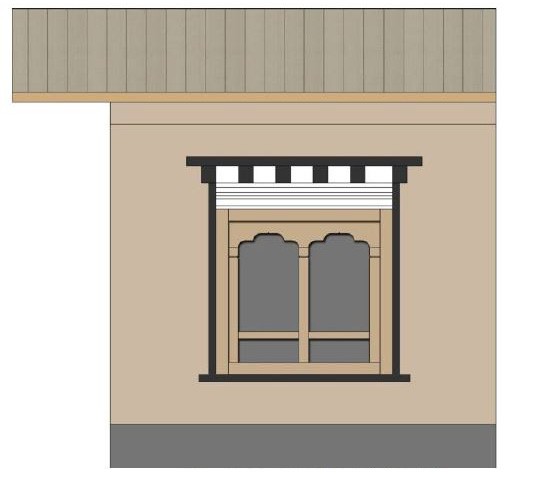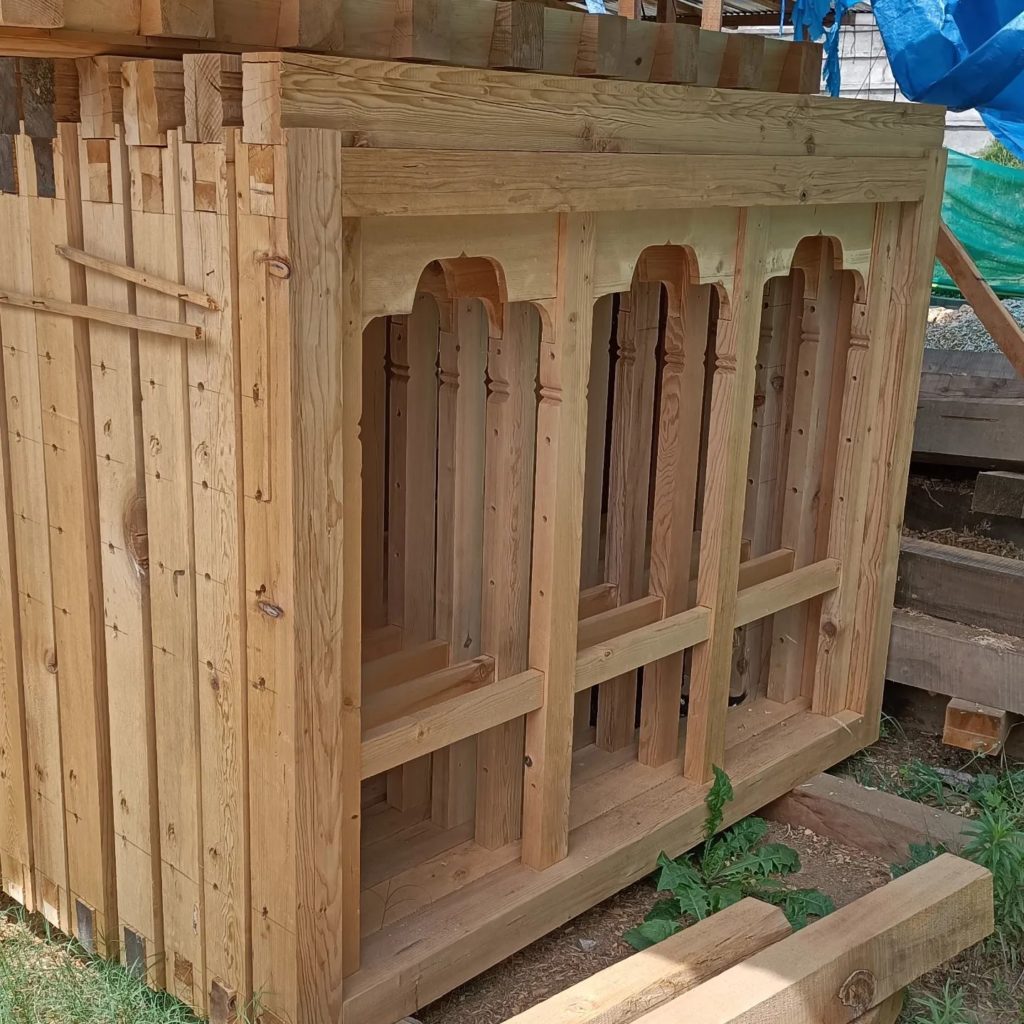All Bhutanese houses are distinctively unique from the rest of the world. Do you have any questions about how to proceed with the Bhutanese house design? Here, we will discuss a unique feature of Bhutanese houses—Bhutanese windows. This article will guide you through the different types of Bhutanese windows and their features, specifications, and common use in types of buildings in regions.
Bhutanese Windows
Traditional Bhutanese windows are particularly unique in their design and explicitly stunning. They are featured with essential traditional items signifying religion and mythical creatures. This type of window consists of a series of horizontal and vertical frames that can be joined with the help of the wood joining technique.
No nails or screws are used to connect the members of the window components; Or infect the entire house is constructed without the use of single nails or screws in earlier times. Even some temples and other (rural) structures were constructed without the use of nails today.

Feature of Bhutanese Window
Here are some key features of Bhutanese windows:
Wooden Lattice: Bhutanese windows feature a wooden lattice running horizontally and vertically. These lattices not only add to the aesthetic appeal but also serve structural integrity to the window itself. It also serves adequate ventilation and a wider opening allows entry of more light.
Intricate Carvings: Those windows that are curved, often include floral patterns, religious symbols, and mythological figures. These carvings are typically done by skilled artisans and reflect the rich cultural heritage of Bhutan. However, not all Bhutanese windows are curved with intricate designs. This is also not permitted by tradition and culture. For example, windows used for the toilet and basement are not provided with intricate curving.
Decorative Painting: The woodwork around Bhutanese windows is often painted in bright colours. Traditional Bhutanese colour schemes include red, gold, green, and blue, which are not only visually striking but also have symbolic meanings in Bhutanese culture.
Cultural Significance: Bhutanese windows reflect the importance of Buddhism in Bhutanese life. Many designs incorporate religious symbols such as the lotus flower, the endless knot, and other auspicious symbols, highlighting the spiritual dimension of Bhutanese architecture.
Functionality and Design: The design of Bhutanese windows takes into consideration the local climate and the need for natural light and ventilation. The windows are usually small in size but numerous, allowing sufficient light and air into the rooms while preserving the warmth inside during colder months.
Components of Bhutanese Windows
The traditional Bhutanese window should consist of certain elements or features. Mullion and Transom of the traditional window have different local names. The design should comply with the Architectural guidelines of Bhutan and the regulations of the Development Division of the department. The features are:
- Chidhen: It is another name for the window sill or the lowest part of the window. Chidhen is a timber plank of thickness varying from 50 to 100mm thick. In modern construction techniques, concrete sill or brick sill are used to support the windows that are painted with traditional paint. Chidhen are provided to prevent inclined cracked development on the masonry wall below the window.
- Mathoe: It is the name given to the bottom frame of the window. It forms a frame of the window and it is a timber batten of thickness 100 to 125mm.
- Thrangcho: The horizontal members, made of a timber plank with a thickness ranging from 25 to 50mm are laid above the mathoe. Their primary function is to maintain the horizontal alignment of the upper window components.
- Barthoe: This is the middle frame in the two-tier window. It usually misses the single-tier window. It should be of the same size as the Mathoe.
- Kachung: The inner vertical frame enclosed by the outer frame is called a Kachung. They support the Horzhun and divide the window into several eyes.
- Loshog: The outermost vertical frame is Loshong. The width of Loshong is equal to the thickness of the wall and is usually provided in houses where the wall is constructed from stone masonry, rammed earth wall and adobe wall.
- Horzhu or Zing: The upper horizontal part of the Kachung with the inner two or three curves at one side is called Horzhu or Horzin.
- Yathoe: It is the uppermost horizontal part of the window frame. Its dimension is as same as that of the other frame.
- Cornice: A traditional cornice is a composition of several elements that must be incorporated into every Bhutanese window. The hierarchy of the elements is in the sequence of Dhung at the bottom, Pem-Choetse, Bogh and Ka, and Zangshing at the top.
- Zangshing: This is the top component of the window. It is equivalent to the lintel rest on the window and door. The width of the Zangshing is equal to the wall thickness and the depth is not less than 75 mm. In the masonry wall constructed of stone, the Zangshing on the window is usually 150mm of 2 numbers where the wall thickness is more the 400mm.
Types of Bhutanese Windows
In this article, we have classified Bhutanese windows into two main categories based on their historical appearance: –
- Traditional Bhutanese Window (includes 4 types)
- Contemporary Bhutanese Window (modification to the traditional window)
Traditional Bhutanese Windows
The traditional windows are known as Payab Gochu (local language)which are embedded within the facade walls of a building. Payab Gochu featured traditional elements and has been in use for several centuries. However, there have been a lot of improvements in the design. There are four main types of traditional windows as featured in “Architectural guideline of Bhutan” as follows: –
- Horgo Payab
- Lingo Payab
- Gedkar Payab
- Boego Payab
The word Payab Gochu translates to the windows in local dialects and is simple compared to the design of the Rabsel or Rabsey. The traditional Bhutanese architecture of the Payab Gochu involves the use of timber boards, such as Loshog on the sides, Chiden as a sill at the lower level, and Zangshing as a lintel at the upper part.
Additionally, a layer of Bogh (cornices) is commonly incorporated above the Payab Gochu, supported by layers of Pem, Choetse, Dhung or Zumchu, and Yathoe (timber window framework). The layer of Bogh may be single or double, and sometimes Phana is added depending on the building’s significance or budget. Dhung may be omitted, in which case Zumchu is placed directly on Yathoe.
Horgo Payab
The Horgo Payab is a traditional window that has a double-tier eye with an opening available at the two ends and the middle eyes are usually fixed. This type of window is embedded in the wall. The walls are usually of stone masonry, adobe walls and rammed earth walls.

Best Uses
These types of windows are best used in all types of traditional Bhutanese buildings such as residential houses, monasteries, temples, and Dzong. They are not used in Stupas or Chorten. They are usually used in buildings that have multiple stories (more than one story).
Boego Payab
The Boego Payab is a traditional window that has a resemblance to the Tibetan window. However, Tibetan windows lack the Horzhu and they are just fabricated with rectangular openings. The prefix “Boe” means Tibet in Dzongkha and the design of this type of window is believed to be brought to Bhutan after the arrival of Zhabdrung Ngawang Namgyel. The type of window is put to use with the construction of Dzong and Lhakhang.
This type of window is further classified into two categories depending upon the double or triple tier of Horzhu. Triple tier Horzhu window is most commonly used in the Dzong, Lakhang and other important buildings. Double-tier windows are normally seen used in residential houses, school buildings, institution buildings, Chorten (stupa) and in the buildings where windows feature elements.

Best Uses
These type of windows is usually used in single as well as multi-storied buildings. But they best fit in single-storied houses or ground floors of buildings. They are used in all types of buildings in monasteries, dzongs, temples, residential buildings, and Chortens.

Lingo Payab
This is one of the oldest forms of the window in the Himalayan region. The window is known to originate from a place called Ling in Tibet. Lingo Payabs are commonly used in some of the old Bhutanese buildings such as Dzong (fortress/castle), Lhakhang (temple), and palaces on the ground floor or basement, sometimes even in the attic. As said earlier, a similar type of window is being used in the eastern Himalayan region such as Nepal, Tibet, Bhutan, and the northern states of India (Arunachal Pradesh and Ladakh) due to the influence of Ling Geser. However, the window used in these regions has little variation in design.
Feature of Lingo Payab:
Unlike Horgo and Boego Payab, it does not have Horzhu, Kachung or Tshigen. It is sometimes built with a timber plank embedded at the base known as Thrangcho with a maximum height of 450mm. It has multiple transoms including Jugshing.

Gedkar Payab
Lingo Payab and Gedkar Payab are almost identical to each other. With closer inspection and as per the architectural guidelines of Bhutan, they are differentiated by the size of the openings. Lingo Payab is featured with a wider opening.
Unlike Lingo Payab, Gedkar Payab is shorter in height and has a narrow opening. It is usually installed in the rooms that are less important (like a store, toilet, basement and animal shelter). Gedkar Payab is constructed without the intricate design and traditional base (Yeotsheon) painting is usually applied to it.
Gedkar Paya has an opening of 100-250mm along the width with the openable shutter if provided. A window of this type is embedded in the wall or flushed with the surface of the wall finish.
Feature of Gedkar Payab:
Gedkar payable lacks Thrangcho and instead features multiple smaller openings with transoms. It has the possibility of including Horzhu, Zangshing, Bogh, and Zumchu, but Pem-Choetse or Dhung are not necessarily included. Additionally, Shamig, Tshigen, and Kachung are excluded from Gedkar. The shutter frame will be concealed behind the window frame. Gedkar Payabs are designed to appear narrower in comparison to other Payabs.

Contemporary Windows
Contemporary windows are those windows that are the modifications made to traditional windows. Such windows are a combination of two or more types of traditional windows. Usually, a combination of Lingo Payab and Bego Payab is adopted by the School Planning and Building Division for the school buildings. This type of window is sometimes fabricated with modern building materials keeping the essence of traditional elements. Contemporary windows are constructed with Mild steel, aluminium, and other materials (like glass-reinforced concrete, UPVC, etc.).

Aluminium and Steel (Mild steel) windows are common in the southern region of the country. Whereas, aluminium windows are commonly seen in the central region. The use of UPVC windows is becoming popular in the region.
Also, read: What Should Be The Size of The Window?
Traditional Window Shutters
Traditional window shutters are provided with solid timber plank with a thickness varying from 20 to 35mm thick. These shutters are openable either by sliding or hinge opening. The sliding shutters are provided for the window at Rubsel. The Payab windows are facilitated with a hinged shutter on either side of the windows. This type of window shutter is still in use in some monasteries, Lakhang (temples), and rural houses.
Glass window shutters with timber or aluminium frames are common in the modern days. Glass with timber frame shutters is usually openable with hinges provided at one side. Aluminium shutters are either sliding or hinged and are provided to the Traditional Bhutanese window as well.
Also, read: Type of Rabsel used for Bhutanese Building Construction?
Materials for Traditional Windows
Timber is the most common material for the construction of traditional Bhutanese windows. Blue pipe and other conifer timber are used for door and window construction in the temperate region. Hardwood like teak, sal and others are used in the southern region. Other materials, such as glass, are secondary materials for windows, especially shutters. Blue pine, conifer and teak wood are the woods for making window components.
There are other materials for the fabrication of windows. They include fibreglass, Mild steel and Aluminum. These materials are commonly used in Bhutanese windows either in Traditional or Contemporary Windows types.

Painting for Bhutanese Windows
All Bhutanese windows are uniquely painted using traditional paintings. However, this has diminished over time while keeping all the elements intact; and also due to the use of modern materials. Especially, when the windows are fabricated with steel (usually mild steel), UPVC or aluminium. The paints applied to the windows largely depend on the criteria set by the government and the eligibility of the individual.
Traditional paint is applied to the window usually with a certain pattern over the base paint. Some of the homeowners escape the pattern when applying traditional paint and this is termed Yutshon. There are two types of traditional paint applied to the window and Sumdang paint is eligible for all Bhutanese. Dangtshon paint is for internal decoration of all kinds of buildings and external applications for only Royal cottages.
These two categories of paints are further identified into three types; – Rab, Ding, and Thamar which translate to excellently, good and average respectively. Also, the application of Rab painting is only for institutions and public buildings. Ding and Thamar are for common people’s usage only.
Also, read: Bhutanese Painting for Building Construction in Bhutan. | Types | Significant | Specification
FAQs
Q: What are the types of traditional Bhutanese windows?
Answer: Traditionally, Bhutanese windows are of 4 types as follows: –
1. Horgo Payab
2. Lingo Payab
3. Boego Payab
4. Gedkar Payab
Q: What is the feature of the Bhutanese window?

Answer: The feature of the Bhutanese window is that it is fabricated with timber, engraved with traditional elements (cornices), and painted with Bhutanese painting.
Q: What is the main difference between Lingo Payab and Gedkar Payab?
Answer: The main difference between Lingo Payab and Gedkhar Payab is that the size of the opening is different as Lingo Payab has a much wider opening whereas Gedkar Payab has an opening ranging from 100-250mm.
Q: What is the standard size of a Bhutanese window?
Answer: There are no such things as a standard size for Bhutanese windows as of now. However, the size is determined by the requirement of an opening for the lighting and air circulation and the type of Bhutanese window.
Q: What is the significance of the Bhutanese window?
Answer: Bhutanese windows are an important feature of Bhutanese architecture and are often decorated with symbolic designs that are based on Buddhist philosophy. The design of the windows is said to represent the “three jewels” of Buddhism: Buddha, Dharma, and Sangha.
References: –
- Ministry of Works and Human Settlement, Royal Government of Bhutan. (2014). Bhutanese Architecture Guideline. Retrieved from. https://www.moit.gov.bt/wp-content/uploads/2010/11/Bhutan-Arch-Guidelines-final-2014.pdf
- Ministry of Communications, Department of Urban Development and Housing. (1993). Traditional Architecture Guideline. Retrieved from. http://admin.theiguides.org/Media/Documents/TRADITIONAL-ARCHITECTURE1.pdf
- SPBD. (1998). Specification for Civil and Electrical works. (15th rev. 2013). School Planning & Building Division. RGoB. MoE. Thimphu
![]()







